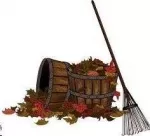Nov 9, 2019

The growing season isn't over until the ground freezes according to planetnatural.com.
For a lot of us, November marks the end of our outdoor gardening season. There’s still puttering to do: cleaning and oiling tools to be put away for the winter, bringing indoors any potted plants we may still have outside, trimming back and protecting roses; that kind of thing. Often we’ll wait for a sunny (relatively) warm day to do these things. But as all of us have heard said, "it ain’t over ’til it’s over." And in gardening, that means it ain’t over until the ground freezes, no matter what the calendar says.
How so? As long as you can get a spade in the ground, the ground can still be worked. That means you can still plant bulbs for spring blooming. Lots of experts will tell you that bulbs need to be planted around the time of the first frost and several weeks ahead of the ground freezing. We’ve found that this isn’t necessarily true. Bulbs planted well after the first frost will do quite well as long as the freeze is gradual and not the result of a sudden and prolonged cold snap. The main thing here is to avoid over watering. Everyone knows bulbs don’t like wet feet. When the solid freeze comes you don’t want your bulbs to be too damp which may cause them to be damaged.
Another thing about bulbs. They don’t store well. You’ll probably lose less of them by sticking them in the ground even in winter than you would trying to hold them over until next fall. And what a pleasant surprise you’ll have come spring and the first tubers start poking through the thawing earth. So don’t save ’em, plant ’em.
Here’s one we don’t need to tell you: dig up root crops still in the ground. Yes, we like to mulch our carrots heavily and continue to pull them well into December. Somehow they seem sweeter the later in the season it is. But especially if you live where the winters can be hard — Bozeman, Montana, anyone? — you’ll want to get your rutabagas, turnips, carrots and whatever else out of the ground and into the basement or root cellar before they’re impossible to dig or/and buried in snow.
What else? We like to prepare planting beds for those early spring vegetables, like peas. Turning and amending the soil now, maybe even laying out rows, will save you a lot of time come March when that first group of sunny days after the ground has thawed gives you gardening fever and you want to get something in the ground. You won’t have to wait for the soil to dry so you can work it. And there’s something great about telling your friends on a cold day in March that your peas are already in. Jump-start!
We actually like to plant certain, cold hardy crops — kale is a perfect example — in November. This, like much of late-season planting, is a gamble but can reward the risk-adverse with early season greens. Sometimes a bit of good weather will allow the kale to sprout and start to grow before real winter sets in. More often, it won’t break the ground until spring. The secret is to mulch heavily with a good, insulating material, like straw. If you see signs of sprouting in the weeks after you’ve planted, add even more mulch. On those last days of winter when you get (again, a relative warm spell) I defy you to resist the temptation of pulling back the cover to see what’s happening. You might be surprised. In addition to kale, spinach and some types of lettuce will also produce spring time results when planted in this way. But again, it’s a gamble. What else are you going to do with that left over seed?
One other thing you should consider doing before the ground freezes. Prepare the hole for your living Christmas tree to go in once the holidays are over. While there are specific tricks and techniques for keeping a living tree alive, it’s best to be prepared. You can fill the hole with leaves until you’re ready to plant. A weighted tarp will keep the top layer in place.
And while we’re on trees, keep watering them ahead of the ground freezing. They’re facing a long hard winter and anything you can do now to help them will be rewarded later with healthy growth.
What digging are you doing in the vegetable plot late in the season? And lets us know when the ground has frozen in your area. We suspect that you’re like us: we can’t just let the garden go. Need some more ideas once the digging is done? Thank you, Iowa State University.
Share this article with friends!
Tags:
#leaves,#fall#starzpsychics.com,#starz#advisors

